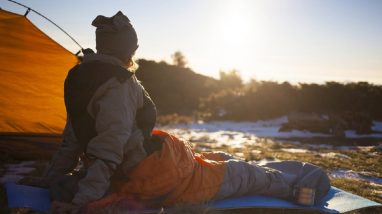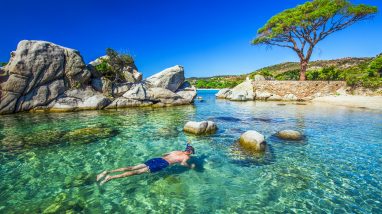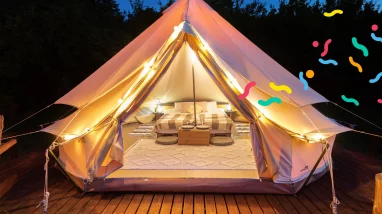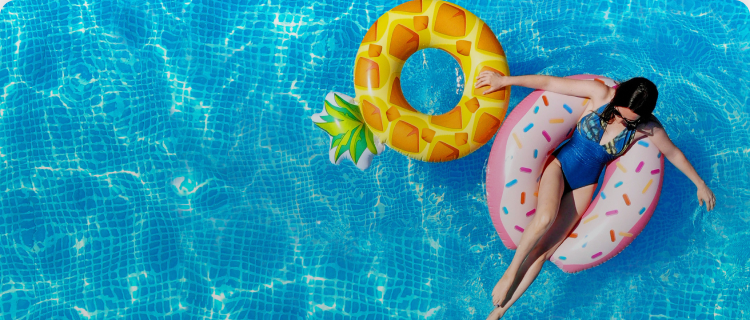Are you planning on camping this Winter? Check our article with 4 cold-weather tent camping tips and hacks for your next big outdoor adventure.
Like any true lover of the outdoors, a little snow can’t stop you.
In fact, the cold season is one of the best times to camp. Most of the tourists are gone, meaning you’ll have peace and quiet. The bugs are gone. You also get to see another side of the most beautiful natural landscapes in the world.
There’s nothing like waking up to blankets of pristine snow glittering all around you. Of course, this weather also presents some obstacles.
Camping in the cold can be dangerous. You may have to contend with some scary conditions, like frostbite or hypothermia. However, these threats are not as daunting as they sound if you do your research and are adequately prepared.
Check out these 4 tips and hacks to make sure you’re prepared for your next cold-weather tent camping trip.
Layers on Layers on Layers
It doesn’t take a rocket scientist to know you won’t be packing your swimsuit for a cold weather tent camping trip, but the clothes you do choose are essential to your survival.
Like a good sandwich, your clothing choices are most successful if you focus on your layers. These consist of the base, mid-layer, and outerwear.
The base layer is there to wick moisture from your body. Without this layer, the sweat from physical exertion will stay trapped, leaving you damp. That’s a recipe for hypothermia.
For this layer, make sure you choose wool or synthetic fabrics – thermal underwear is usually a combination of these.
Now, for the mid-layer, you still need something that will pull the moisture out, but also keep you insulated. Most people choose fleece for that. You can double up on mid-layers if you think it’s necessary. It’s better to have to strip down than not be able to suit up.
Finally, the outer layer. This needs to protect you from the elements, like wind, but especially condensation. Choose fabrics that will continue the moisture wicking process so it can escape and evaporate, leaving you dry and comfortable.
Waterproof fabrics that breathe are essential, but make sure they are also windproof. This is not just advice for upper body layers, but lower body as well!
Don’t forget to invest in a suitable scarf or neck gaiter to not only keep you warm but protect your face. The cold, the wind, and the amplified UV sun rays reflecting off the snow can severely damage your skin.
Although the old adage that most heat escapes through your head has been debunked, adding a fleece cap to your ensemble wouldn’t hurt. Match it with a pair of nice gloves. Remember – everything should insulate and breathe!
Shoes, or Issues
But wait, there’s more! Your shoes and socks are just as important, if not more so than your clothes.
First, the socks. You need a fabric that will move sweat. Damp feet means cold feet, which means more opportunity for injury. To prevent this, only wear wool or synthetic fibre socks that fit well and come up to your mid-calf or knee.
The shoes, like your outer layer, are protecting your feet from the elements. They must be water repellent and insulated.
Boots with removable liners are great because you can sleep with them and dry them out without having them freeze.
With so many options to choose from, it may be wise to look into renting some boots and testing them out before you make a commitment.
When you’re finally ready to make the big purchase, make sure to look into the retailer and manufacturer return policies. It will not only save you money, but also a headache.
Rest Like the Best
How you sleep is just as important as what you wear when cold weather tent camping.
Not everyone uses sleeping bags with the same temperature rating, and that’s perfectly fine. What matters is that you find what works for you.
You’ll have to choose whether you want a one bag or two bag system. While lugging one bag is less bulky, a two bag system could help you regulate your temperature better if you’re somewhere where the climate wildly fluctuates.
No matter what you choose, make sure your sleeping bag follows the two key rules – insulate, but breathe!
Additionally, you’ll need a decent sleeping mat so the cold, frozen ground doesn’t drain all your heat. You’ll have to choose: air mat, self-inflating mat, or closed-cell foam mat?
Like mid-layers and sleeping bags, it never hurts to double up. You can’t predict which sleeping mat will work best for you without trying them out, so search for a local retailer and get down there.
Extra Tips
Before heading to bed, heat up some water, put it in your bottle, and throw it in your sleeping bag. Then, do some light exercise to get your blood pumping and warm up your body. When you lay your head to sleep, you’ll feel nice and toasty.
In fact, you can move that hot bottle around as you see fit to heat any cold spots. You’ll also have some fresh water to drink in the morning, right at your fingertips.
You’ll definitely want to pass out early after a long day of hiking, but resist the urge. The earlier you’ll pass out, the earlier you’ll wake up – sometimes that means 3 AM. Hang out by the campfire until at least 8 PM to get the best amount of rest.
Lastly, having to relieve yourself in the middle of a cold winter night is always daunting, but just do it. You’ll ruin your rest if you try to hold it in, and you’ll still end up getting up anyway.
Cold-Weather Tent Camping Experts
No matter your destination, what’s better than a local expert to guide you in the ways of survival? At Campsited, we’ve created detailed guides on camping throughout multiple countries, and we’re always ready to connect people with Mother Nature.
Are you ready to book your trip? Check us out while you’re online shopping for new gear.
We’ve provided links for you below to help you choose camping parks in Scotland, England, Wales and Ireland.














